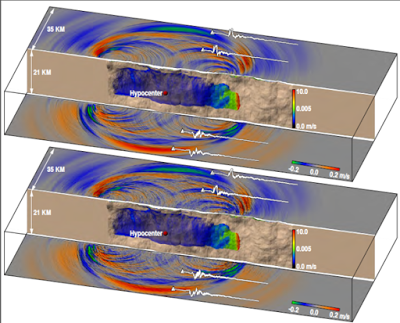
Most models of ground motion during earthquakes have the earth shifting and grinding, then returning to essentially the same state as before once the temblor ends. But during earthquakes, especially large ones, the earth gets transformed. It crumbles and breaks apart, and in extreme cases even liquefies. These terrestrial transformations are known as nonlinear effects, and they may impact how much damage certain temblors can cause.
If a massive magnitude 8.0 earthquake rocked the San Andreas Fault, certain properties of the Southern California region’s shallow sediments might mean the quake would shake less than previously estimated. Kim Olsen, a geologist and earthquake expert at San Diego State University, recently was awarded a $57,000 grant from the U.S. Geological Survey to study these nonlinear effects.
Shake and rattle
It’s harder for an earthquake’s waves to transmit as much energy through this broken-up earth, meaning that the quake’s amplitude winds up being dampened in the process. This earthen breakup is more likely to occur in areas with unconsolidated sediment—clay, sand and gravel—and during large, powerful earthquakes. That means, somewhat counterintuitively, that the Big One might be so powerful that nonlinear effects near the fault limit the amplitude of certain waves, dramatically reducing the damage much further away.
“A 7.8 or 8.0 magnitude earthquake on the San Andreas might halve the amplitude of the shaking in certain parts of Los Angeles as a result of nonlinear effects,” Olsen explained.
Olsen and his colleagues in the San Diego Supercomputer Center—made up of researchers from SDSU and the University of California, San Diego—are using supercomputing technology to model earthquakes that incorporate these nonlinear effects.
Prize-winning code
This team of researchers recently won a $150,000 grand prize from the technology company NVIDIA in a competition to find real-world applications for the company’s accelerated graphics processing unit (GPU) technology.
Olsen and his SDSU colleague Steven Day created the code which, for the competition, was used to simulate high-frequency seismic waves in the range of 0-10 Hertz, the kind of waves that tend to cause the most damage to single-level and two-story homes. Their simulations could be used to test and potentially overhaul earthquake building codes to make homes safer, Olsen said
NVIDIA’s accelerated GPU technology allowed the simulation to run about five times faster than it would ordinarily. By incorporating the accelerated GPU, researchers can do their work more quickly and efficiently.
“We’re excited that we got this speed-up,” Olsen said. “Now we want to use it and get some results.”
Note : The above story is based on materials provided by San Diego State University.










